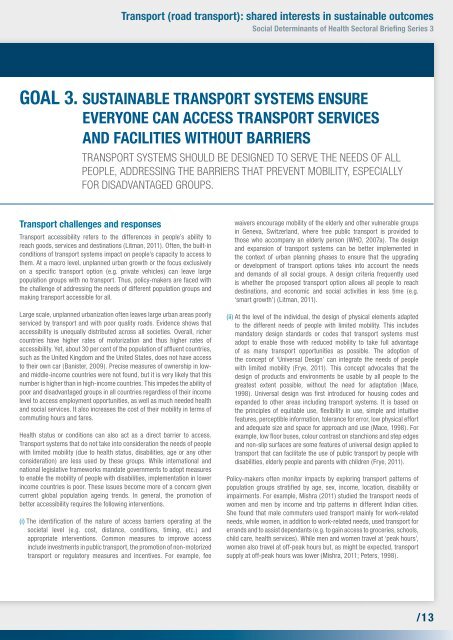Social determinantS of health Sectoral briefing SerieS 3
Social determinantS of health Sectoral briefing SerieS 3
Social determinantS of health Sectoral briefing SerieS 3
You also want an ePaper? Increase the reach of your titles
YUMPU automatically turns print PDFs into web optimized ePapers that Google loves.
transport (road transport): shared interests in sustainable outcomes<br />
<strong>Social</strong> determinants <strong>of</strong> <strong>health</strong> <strong>Sectoral</strong> briefi ng Series 3<br />
goal 3. SuStainable tranSport SYStemS enSure<br />
eVerYone can acceSS tranSport SerViceS<br />
and facilitieS Without barrierS<br />
TRANSPORT SYSTEMS SHOULD BE DESIGNED TO SERVE THE NEEDS OF ALL<br />
PEOPLE, ADDRESSING THE BARRIERS THAT PREVENT MOBILITY, ESPECIALLY<br />
FOR DISADVANTAGED GROUPS.<br />
transport challenges and responses<br />
Transport accessibility refers to the differences in people’s ability to<br />
reach goods, services and destinations (Litman, 2011). Often, the built-in<br />
conditions <strong>of</strong> transport systems impact on people’s capacity to access to<br />
them. At a macro level, unplanned urban growth or the focus exclusively<br />
on a specifi c transport option (e.g. private vehicles) can leave large<br />
population groups with no transport. Thus, policy-makers are faced with<br />
the challenge <strong>of</strong> addressing the needs <strong>of</strong> different population groups and<br />
making transport accessible for all.<br />
Large scale, unplanned urbanization <strong>of</strong>ten leaves large urban areas poorly<br />
serviced by transport and with poor quality roads. Evidence shows that<br />
accessibility is unequally distributed across all societies. Overall, richer<br />
countries have higher rates <strong>of</strong> motorization and thus higher rates <strong>of</strong><br />
accessibility. Yet, about 30 per cent <strong>of</strong> the population <strong>of</strong> affl uent countries,<br />
such as the United Kingdom and the United States, does not have access<br />
to their own car (Banister, 2009). Precise measures <strong>of</strong> ownership in Iow-<br />
and middle-income countries were not found, but it is very likely that this<br />
number is higher than in high-income countries. This impedes the ability <strong>of</strong><br />
poor and disadvantaged groups in all countries regardless <strong>of</strong> their income<br />
level to access employment opportunities, as well as much needed <strong>health</strong><br />
and social services. It also increases the cost <strong>of</strong> their mobility in terms <strong>of</strong><br />
commuting hours and fares.<br />
Health status or conditions can also act as a direct barrier to access.<br />
Transport systems that do not take into consideration the needs <strong>of</strong> people<br />
with limited mobility (due to <strong>health</strong> status, disabilities, age or any other<br />
consideration) are less used by these groups. While international and<br />
national legislative frameworks mandate governments to adopt measures<br />
to enable the mobility <strong>of</strong> people with disabilities, implementation in lower<br />
income countries is poor. These issues become more <strong>of</strong> a concern given<br />
current global population ageing trends. In general, the promotion <strong>of</strong><br />
better accessibility requires the following interventions.<br />
(i) The identifi cation <strong>of</strong> the nature <strong>of</strong> access barriers operating at the<br />
societal level (e.g. cost, distance, conditions, timing, etc.) and<br />
appropriate interventions. Common measures to improve access<br />
include investments in public transport, the promotion <strong>of</strong> non-motorized<br />
transport or regulatory measures and incentives. For example, fee<br />
waivers encourage mobility <strong>of</strong> the elderly and other vulnerable groups<br />
in Geneva, Switzerland, where free public transport is provided to<br />
those who accompany an elderly person (WHO, 2007a). The design<br />
and expansion <strong>of</strong> transport systems can be better implemented in<br />
the context <strong>of</strong> urban planning phases to ensure that the upgrading<br />
or development <strong>of</strong> transport options takes into account the needs<br />
and demands <strong>of</strong> all social groups. A design criteria frequently used<br />
is whether the proposed transport option allows all people to reach<br />
destinations, and economic and social activities in less time (e.g.<br />
‘smart growth’) (Litman, 2011).<br />
(ii) At the level <strong>of</strong> the individual, the design <strong>of</strong> physical elements adapted<br />
to the different needs <strong>of</strong> people with limited mobility. This includes<br />
mandatory design standards or codes that transport systems must<br />
adopt to enable those with reduced mobility to take full advantage<br />
<strong>of</strong> as many transport opportunities as possible. The adoption <strong>of</strong><br />
the concept <strong>of</strong> ‘Universal Design’ can integrate the needs <strong>of</strong> people<br />
with limited mobility (Frye, 2011). This concept advocates that the<br />
design <strong>of</strong> products and environments be usable by all people to the<br />
greatest extent possible, without the need for adaptation (Mace,<br />
1998). Universal design was fi rst introduced for housing codes and<br />
expanded to other areas including transport systems. It is based on<br />
the principles <strong>of</strong> equitable use, fl exibility in use, simple and intuitive<br />
features, perceptible information, tolerance for error, low physical effort<br />
and adequate size and space for approach and use (Mace, 1998). For<br />
example, low fl oor buses, colour contrast on stanchions and step edges<br />
and non-slip surfaces are some features <strong>of</strong> universal design applied to<br />
transport that can facilitate the use <strong>of</strong> public transport by people with<br />
disabilities, elderly people and parents with children (Frye, 2011).<br />
Policy-makers <strong>of</strong>ten monitor impacts by exploring transport patterns <strong>of</strong><br />
population groups stratifi ed by age, sex, income, location, disability or<br />
impairments. For example, Mishra (2011) studied the transport needs <strong>of</strong><br />
women and men by income and trip patterns in different Indian cities.<br />
She found that male commuters used transport mainly for work-related<br />
needs, while women, in addition to work-related needs, used transport for<br />
errands and to assist dependants (e.g. to gain access to groceries, schools,<br />
child care, <strong>health</strong> services). While men and women travel at ‘peak hours’,<br />
women also travel at <strong>of</strong>f-peak hours but, as might be expected, transport<br />
supply at <strong>of</strong>f-peak hours was lower (Mishra, 2011; Peters, 1998).<br />
/13
















